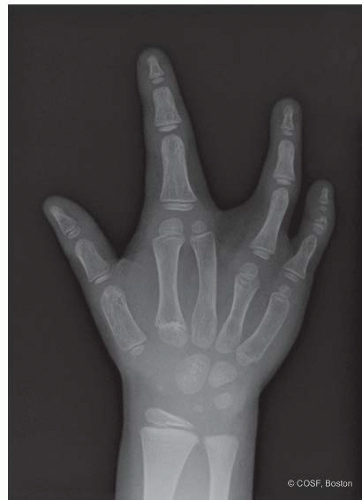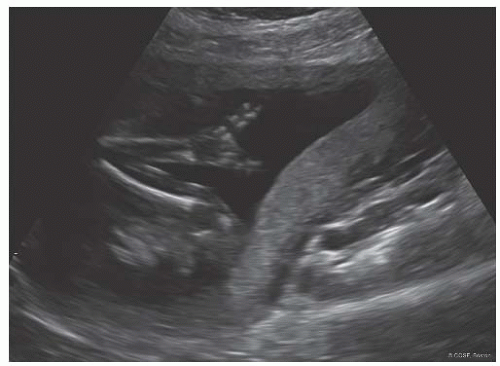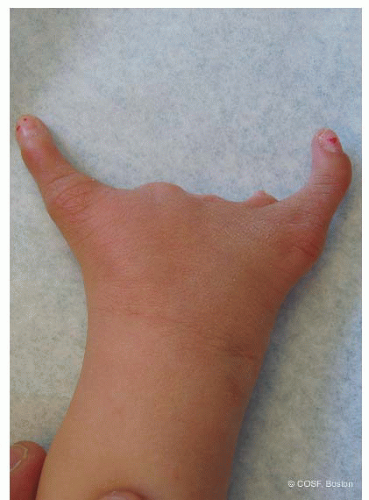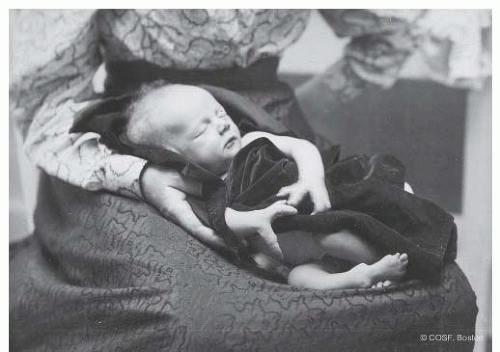Central Deficiency and Symbrachydactyly
CASE PRESENTATION
An 18-week-pregnant mother is referred to the advanced fetal care center for ultrasound evidence of cleft hands (Figure 8-1). The father has cleft hands that had surgery as a young child. The ultrasound is otherwise normal for organ system development. The parents want to know how far medical science and surgical advances have come since dad’s childhood.
CLINICAL QUESTIONS
What are the genetic causes of cleft hands?
What are the associated conditions, if any, with typical cleft hands?
How are cleft hands classified?
Is there nonoperative treatment?
What are the surgical principles for typical cleft hands?
What are the expected results of surgical treatment?
What are the complications?
THE FUNDAMENTALS
Approach the game with no preset agendas and you’ll probably come away surprised at your overall efforts.
—Phil Jackson
Functional grasp, pinch, and release are critical for independent activities of daily living. Less than the full complement of independent, aligned, mobile fingers and thumbs can limit function. Bilateral disorders, even in the presence of a normal-functioning brain, can compromise opportunities and choices in life. So can unilateral hand disorders, though less so. Cleft hands are usually bilateral and always have digital absence and deformities. The cosmetic and social concerns and implications of cleft hands are real and important for the child and family.
Typical (ectrodactyly) (Figure 8-2) and atypical (symbrachydactyly) (Figure 8-3) cleft hands are rare. With ectrodactyly, the basic principle is to close the cleft and deepen the first web space in order to preserve or enhance grasp, pinch, and release, as well as to improve cosmesis. This chapter mostly addresses typical cleft hands. Symbrachydactyly treatment is also covered in Chapter 9.
Etiology and Epidemiology
Cleft hands occur in 1:10,000 to 1:90,000 live births depending on phenotypic classification.1,2 There is a clear genetic basis for typical cleft hands. Phenotypic expression is variable with approximately 70% of individuals with the genetic abnormality having clinical manifestations. Clefts can be present in one to four limbs. There is considerable variability in the degree of hand and foot abnormalities, but central deficiencies are always present.
The genetic basis for cleft hands is well founded in scientific research. Split hand-split foot malformations (SHFMs) are autosomal dominant disorders with variable penetrance. There are five distinct SHFM types with Dlx homeobox gene abnormalities. Ectrodactyly-ectodermal dysplasiascleft lip/palate (EEC) syndromes are due to p63 mutations, an ectoderm-specific transcription factor. The p63 and Dlx proteins colocalize in the nuclei of the apical ectodermal ridge (AER). There is increasing scientific evidence of a transcriptional cascade of events that contributes to ectodermal
development with p63 mutations affecting Dlx homeobox gene regulation.3 A reduction in dactylin transcription is another contributing factor in some cleft hands.4,5
development with p63 mutations affecting Dlx homeobox gene regulation.3 A reduction in dactylin transcription is another contributing factor in some cleft hands.4,5
 FIGURE 8-2 Radiograph of middle finger metacarpal present supporting index finger phalanges and a part of index MCP joint. Index is super digit. |
Cleft hands have been described as a longitudinal central deficiency (type IB International Federation of Societies for Surgery of the Hand [IFSSH] classification).6 Symbrachydactyly has been classified as an undergrowth (type V). More recently, the Japanese Society for Surgery of the Hand proposed a modification to the IFSSH classification7 with (1) all forms of symbrachydactyly being reclassified as type I (longitudinal [1B] or transverse [1A] deficiency) and (2) a new category of failure of ray induction to include typical cleft hand (previous type I), central polydactyly (previous type III), and bony syndactyly (previous type III). This is based on experimental work with embryonic rats treated with a chemotherapeutic agent (busulfan). In this animal model, cleft hands, central polydactylies, and osseous syndactylies were all created from defects in the central hand plate due to failure of induction.8 The experimental data indicate there is diffuse cell death in the central ectoderm and mesoderm with regression of fibroblast growth factor in the AER and bone morphogenetic protein-4 and sonic hedgehog in the mesoderm. A similar pattern of interdigital apoptosis and cartilage condensation leads to abnormal induction of digital rays in cleft hands, central polydactylies, and osseous syndactylies.9,10 There is one clear case of maternal chemotherapy for breast cancer in the first trimester resulting in cleft hands.11
Clinical Evaluation
There is never trouble diagnosing a cleft hand at birth. In fact, many are now diagnosed by prenatal ultrasound. The basic anatomy of four longitudinally aligned metacarpals, supporting four sets of longitudinally aligned, independent triphalangeal digits, with stable, mobile joints, is not present in centrally deficient hands. In addition, the thumb ray is rarely normal. So, evaluation begins by examining every anatomic structure of the hand and determining what is present or absent, what is normal or abnormal. This includes detailed soft tissue specifics, which can be overlooked (such as metacarpophalangeal joint [MCP] ligament stability in the index finger). These hands are so different that you truly need to start at the beginning and move precisely and methodically through clinical and radiographic exam features, ending ultimately with an intraoperative assessment of the anatomy. The surgeon can feel like an airplane pilot doing his or her exacting preflight checks: “Mobile thumb present … Check … Middle finger metacarpal present … No … Small finger normal size … No …” and so on. A high level of detail matters. Surgeons often focus only on the bony structures, which limits the precise understanding and treatment of these unique hands.
Clefts can be central, radial, less commonly ulnar, or in various combinations.12,13 The central cleft is usually V shaped with absent middle finger phalanges. In the mildest clefts, the middle finger phalanges are merely hypoplastic. The middle finger metacarpal can be absent, hypoplastic, bifid, or duplicated. The degree of involvement of the
cleft may extend beyond the absence of the middle ray to include adjacent index and ring finger rays. The ultimate cleft is the presence of the small finger only, adhering to Maisels’ digital suppression sequence.14
cleft may extend beyond the absence of the middle ray to include adjacent index and ring finger rays. The ultimate cleft is the presence of the small finger only, adhering to Maisels’ digital suppression sequence.14
Table 8.1 Manske and Halikis based their classification of central deficiency on the status of the first web space17 | ||||||||||||||
|---|---|---|---|---|---|---|---|---|---|---|---|---|---|---|
|
There are general clinical and radiographic patterns used to classify cleft hands. Nutt and Flatt used the number of digits absent (one, two, or three) as the basis of their classification. Ogino used a similar method but has five subtypes. There are also unusual subsets such as hands with six metacarpals15 or with transverse bones across the cleft.16 Manske and Halikis based their classification of the more common central and radial deficiencies on the status of the first web space (Table 8-1). The spectrum of first web-space changes extends from a normal (I), to narrowed (IIA mild, IIB severe), to syndactylized (III), to merged (IV absence of both index and long finger rays), to an absent first web space (V absent thumb, only ulnar ray[s]). This classification helps surgical planning as closure of the cleft requires a functional thumb and adequate first web space to obtain equivalent or better grasp and pinch function.
Clefts may be unilateral, bilateral, or include one or both feet. The more deficient the first web space (types IIIB-V), the more likely there is to be bilateral hand and foot involvement (23% in Nutt, Flatt study).18 Often there is fourth web-space syndactyly and hypoplasia of the small finger. Clinodactyly, bracketed epiphyses, joint malalignment, and instability are common. Bilateral hand and foot clefts are the most common presentation in SHFM; ulnar clefts are rarer. The ring finger ray may be hypoplastic, partially or completely absent. With complete absence of the small finger or small and ring finger rays, it may be hard to determine if the clinical presentation is a part of mild ulnar dysplasia or an ulnar cleft hand.
Increased incidence of congenital heart disease has been observed in SHFM 1 and SHFM 5 genetic variations.19 EEC by definition has ectodermal dysplasia, cleft lip/cleft palate, and dental anomalies. In addition, EEC has an increased incidence of genitourinary abnormalities.20 Patients with cleft hands and feet have also been shown to have an increased incidence of encephalocele.21 Cleft hands have been described in Cornelia de Lange syndrome.22 There have been rare reports of associated deafness.
Surgical Indications
If you’ve got nothing to do, don’t do it here.
—Brenden “Buff” Blackler
Simple clefts are highly functional;23 more severe clefts have greater functional impairment. Since the brain is normal in these individuals, adaptive function can be high even in the presence of bilateral, marked anatomic variations. Surgery therefore needs to maintain or improve hand function over what is expected from natural history.
Surgical excision of a transverse bone in the cleft with progressive deformity is clearly indicated.16
The psychosocial stigmata of the cleft can vary by individual, family, ethnic group, geographic location, and generations (Figure 8-4). There is no doubt that these
children and adults appear differently than noninvolved peers. How they feel about it and whether you can change that by surgery is unclear. However, most cleft operations are indicated to decrease deformity by cleft closure while maintaining or improving hand function by thumb and first web-space reconstruction.
children and adults appear differently than noninvolved peers. How they feel about it and whether you can change that by surgery is unclear. However, most cleft operations are indicated to decrease deformity by cleft closure while maintaining or improving hand function by thumb and first web-space reconstruction.
SURGICAL PROCEDURES
My players understand that preparation is most important.
—Ben Jacobson, after Northern Iowa upset over number one seed Kansas in the 2010 NCAA men’s basketball tournament
The principle of surgery for cleft hands is simple: close the cleft and optimize the first web-space and thumb function. This applies to Manske and Halikis types I to IV. It is more complicated in the complex deformities with malaligned, unstable, and/or stiff digits adjacent to the cleft. The best outcomes are in the best hands with the best thumbs. Makes sense, right? Even with the busy, referral-and tertiary-care-based practice, cleft hand surgery is rare. Even a high-referral pediatric hand surgeon will maximally see only about two patients and do up to four operations a year if there is bilateral involvement.19 Tonkin and Wood, two senior, very practiced pediatric hand surgeons, presented jointly on their results of 12 Snow-Littler procedures. Experience is hard to come by and counts in these operations.
Stay updated, free articles. Join our Telegram channel

Full access? Get Clinical Tree











